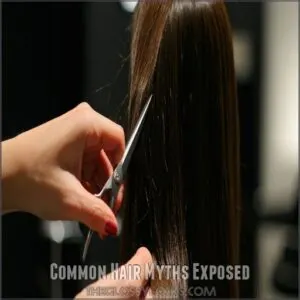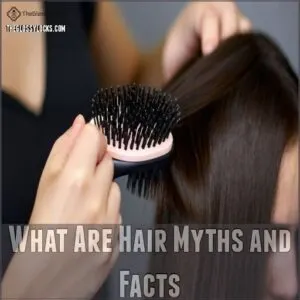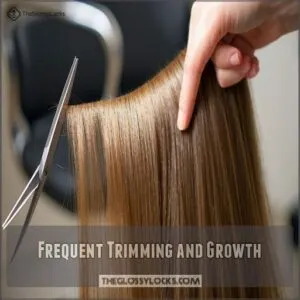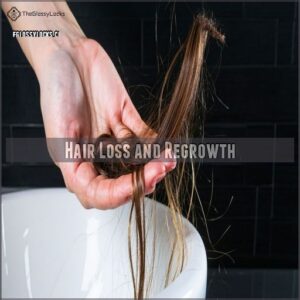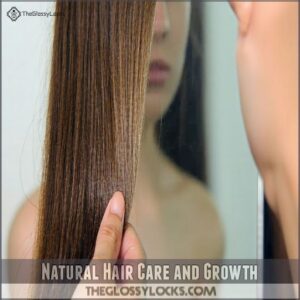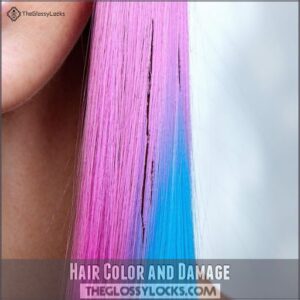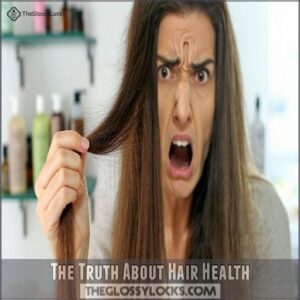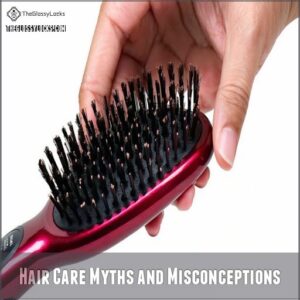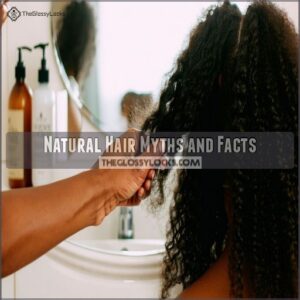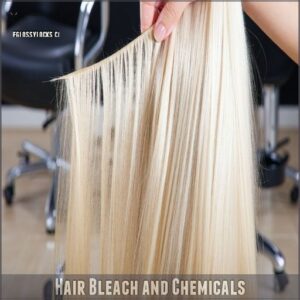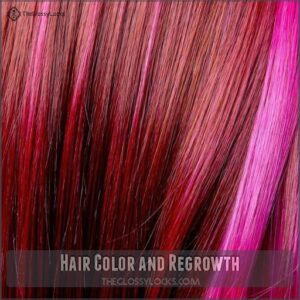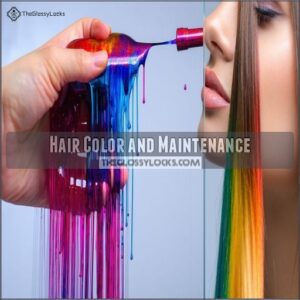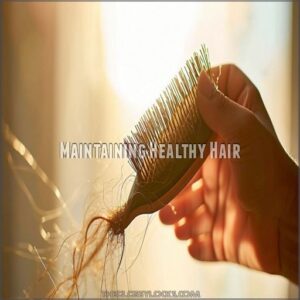This site is supported by our readers. We may earn a commission, at no cost to you, if you purchase through links.
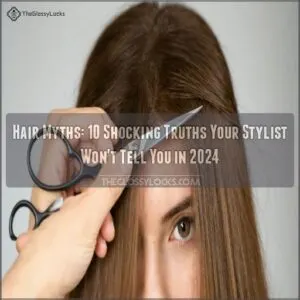 You might think brushing 100 strokes a day keeps your hair healthy or skipping washes makes it grow faster, but these are just hair myths.
You might think brushing 100 strokes a day keeps your hair healthy or skipping washes makes it grow faster, but these are just hair myths.
Stress isn’t turning your hair gray overnight, nor is plucking a gray hair causing more to sprout like weeds.
Sticking with the same shampoo doesn’t make your hair bored, and no, ponytails aren’t always a good idea for everyday wear.
Let’s not get tangled up in myths; understanding real hair facts helps you embrace a healthier routine. Ready to unmask more hair truths? The next revelations might surprise even your stylist!
Table Of Contents
- Key Takeaways
- Common Hair Myths Exposed
- What Are Hair Myths and Facts
- Separating Hair Fact From Fiction
- Debunking Myths About Hair Growth
- The Truth About Hair Health
- Hair Care Myths and Misconceptions
- The Science Behind Hair Myths
- Natural Hair Myths and Facts
- Hair Color and Treatment Myths
- Maintaining Healthy Hair
- Frequently Asked Questions (FAQs)
- What are some hair-related myths?
- Why is there hairfall and no regrowth?
- Why are there so many hair care myths?
- What are some myths about hair growth?
- What is the biggest hair myth?
- Does having long hair in old age, such as in seventies and eighties, cause hair loss?
- What is the mystical significance of hair?
- What does our hair symbolize?
- What is my hair telling me about my health?
- What is the belief of long hair?
- Does washing hair in rice water help growth?
- Can lemon juice naturally lighten hair color?
- Do hair oils speed up growth?
- Is aloe vera effective for treating dandruff?
- Can mayonnaise make hair shinier and smoother?
- Conclusion
Key Takeaways
- You shouldn’t brush your hair 100 times a day; it’ll damage it.
- Trimming your hair doesn’t make it grow faster, but it prevents split ends.
- You don’t need to wash your hair daily; it strips away essential oils.
- Many popular hair care products and methods aren’t backed by science.
Common Hair Myths Exposed
You’ve probably heard countless hair care tips from friends and social media influencers that promise miracle results for your locks.
Let’s examine the most common hair myths that might be damaging your hair,
from the truth about frequent trimming to the real effects of natural oils on your strands.
Cutting Hair and Growth
Believing that frequent haircuts make your hair grow faster? Let’s cut through this myth.
While trimming doesn’t speed up growth, it does prevent breakage and split ends, making your hair appear longer and healthier over time, especially when following a trimming schedule based on your hair’s unique characteristics, such as hair length and texture.
Your hair grows about half an inch monthly from the roots, regardless of how often you trim.
Regular cuts simply maintain the health of your existing length.
Brushing and Hair Health
You’ve probably heard that brushing your hair 100 times before bed leads to healthier locks. Let’s bust that myth! Excessive brushing actually damages your hair’s protective layer, leading to breakage and frizz. Instead, gentle brushing with the right tools can keep your hair healthy.
- Your scalp’s natural oils are like a free conditioning treatment – don’t strip them away with harsh brushing
- That expensive natural bristle brush isn’t magic, but it’s gentler than plastic
- Wet hair is like a stretchy rubber band – brush it wrong and it snaps
- Your grandmother’s 100-strokes rule is doing more harm than good
Split Ends and Repair
Those miracle products promising to fix split ends? They’re leading you down the wrong path. Once a hair splits, no cream or serum can fuse it back together – not even those pricey "repair" treatments.
The only real solution is trimming them off.
That said, Olaplex No. 3 can help prevent future splits by strengthening hair bonds at a molecular level. Regular trims every 8-12 weeks keep your ends healthy.
Shampooing and Effectiveness
While many of us switch shampoos because we think they stop working, this common belief isn’t backed by science.
Your hair’s response to products depends on environmental factors and your hair’s changing needs, not product immunity.
Here’s what really matters for effective shampooing:
- Choose sulfate-free formulas with the right pH balance
- Adjust washing frequency based on your scalp’s oil production
- Focus on proper application technique, not product-switching
What Are Hair Myths and Facts
Every year, hair myths continue to circulate through social media and word-of-mouth, leaving many wondering what’s actually true about hair care.
Let’s break down some common beliefs with solid facts you can trust.
Here’s what science tells us about the most persistent hair myths: Using a hair mask benefits routine can have a significant impact on hair health.
The truth is, many popular beliefs about hair care stem from outdated information or marketing tactics.
Understanding these myths isn’t just about debunking false claims—it’s about making informed decisions for your hair’s health.
With proper knowledge, you can develop an effective hair care routine based on science rather than speculation.
| Myth | Fact | Impact on Hair |
|---|---|---|
| Frequent washing causes damage | Depends on hair type | Can strip natural oils |
| Trimming speeds up growth | False | Prevents breakage |
| Hair products lose effectiveness | False | Consistent results |
| Cold water makes hair shinier | False | Temperature irrelevant |
Separating Hair Fact From Fiction
You’ve probably heard countless hair care tips from friends and social media that sound too good to be true.
Let’s examine what science actually tells us about hair care, from the myth that dirty hair grows faster to the truth about plucking those pesky gray strands.
Dirty Hair and Growth
You’ve probably heard that a proper nutrition and hair growth connection is crucial for strong locks, where protein intake acts as a building block for each strand, and dirty hair grows faster because natural oils nourish the scalp.
Let’s bust this myth wide open.
Clean hair actually grows at the same rate as unwashed hair – about half an inch per month.
But here’s the kicker: excessive oil buildup can clog follicles and slow down growth.
Plus, bacteria thriving in dirty hair can irritate your scalp, potentially damaging follicles.
Plucking Gray Hair
Many people believe plucking gray hairs leads to three more sprouting in their place.
Let’s put this old wives’ tale to rest.
Yanking out those silvery strands won’t multiply your grays, but it can damage your hair follicles, leading to potential bald patches.
Instead of playing tug-of-war with your grays, embrace them or consider professional coloring options that won’t harm your scalp.
Shampooing and Hair Health
Speaking of hair care myths, let’s talk about the shampoo situation. While those flashy commercials suggest daily washing, your scalp’s natural oils tell a different story. Here’s what science actually says about keeping your hair healthy:
- Washing too often strips essential oils
- Sulfate-free shampoos protect your scalp’s microbiome
- Condition from mid-length to ends only
- Hair oiling before washing strengthens your strands
Skip daily washing – your hair will thank you later.
Hair Texture and Strength
Contrary to popular belief, hair texture isn’t a one-size-fits-all story.
While some think coarse hair is stronger, it’s actually more prone to breakage due to its higher porosity.
Understanding your hair’s unique hair shape and texture can help you address specific needs and prevent damage.
Your hair’s strength depends on factors like elasticity, density, and thickness – not just its texture.
Think of it like fabric: silk and wool are different but equally valuable when cared for properly.
Debunking Myths About Hair Growth
You’ve probably heard that frequent trims make your hair grow faster, but this common belief isn’t backed by science.
While trimming helps prevent split ends and breakage, your hair’s growth rate is actually determined by genetics and overall health, not how often you visit your stylist.
Frequent Trimming and Growth
You’ve probably heard that frequent trims make your hair grow faster – but that’s not quite right.
While trimming doesn’t speed up growth (hair grows from the roots, not the ends), it does prevent split ends and breakage by removing damaged ends through techniques like dusting for split ends.
This helps your hair maintain its length instead of breaking off.
Think of it like maintaining a plant – pruning helps it stay healthy, not grow taller.
Hair Loss and Regrowth
While trimming won’t speed up growth, hair loss brings its own set of concerns.
Many believe stress directly causes hair to fall out, but it’s more complex.
Stress can trigger temporary shedding by pushing follicles into their resting phase.
The good news? This type of hair loss usually reverses itself within 6-8 months once you’ve managed your stress levels and maintained proper scalp health.
Natural Hair Care and Growth
Despite what you might hear at the salon, natural hair growth isn’t about fancy products.
Your scalp’s natural oils play a key role in maintaining healthy strands, but excessive product buildup can block follicles.
Pay attention to your hair’s porosity and elasticity – these indicators tell you what your hair really needs.
Focus on scalp health through gentle massage and proper cleansing instead of miracle treatments.
Hair Color and Damage
The myth that hair color always wreaks havoc on your locks isn’t entirely true.
When done correctly, hair dye causes minimal damage compared to bleaching treatments.
Most colors use low-volume developers that gently lift the cuticle, while some don’t use developers at all.
Professional colorists know this secret: it’s not the color that damages hair – it’s improper application and maintenance that leads to breakage.
The Truth About Hair Health
You’ve probably heard countless myths about hair care that just aren’t true, from the idea that dirty hair grows faster to the belief that split ends can be magically repaired with products.
Your hair health depends on understanding what really works, and you’ll be surprised to learn that many common practices, like daily washing and excessive brushing, might actually be working against your goals for healthy, beautiful hair.
Hair Breakage and Split Ends
You’ve heard that trimming your hair makes it grow faster, right?
Science says otherwise.
Here’s the real deal: split ends can’t be magically fixed with products – only scissors can help.
Think of your hair like a rope; once it starts fraying, it’ll keep splitting up the strand unless you cut it off.
Regular trims don’t speed up growth, but they do prevent damage from spreading.
Hair Dryness and Moisture
Frustrated with dry, lifeless locks? Your hair isn’t actually thirsty – it’s protein-starved.
While daily washing strips natural oils, over-moisturizing can make strands limp and weak.
Balance is key: use lightweight oils on damp hair, deep condition weekly, and avoid silicone-heavy products that create fake shine.
Remember, healthy hair needs both moisture and protein to maintain its natural bounce and strength.
Scalp Health and Hair Growth
Understanding that a healthy scalp is crucial, knowing can an itchy scalp mean hair growth helps in determining its impact on hair growth. Beyond moisture levels, a healthy scalp lays the foundation for vibrant hair growth.
Just like a garden needs rich soil, your scalp needs proper care to nurture those hair follicles.
Many people blame their shampoo when they notice thinning hair, but flaky scalps and hair loss often stem from underlying scalp conditions.
Regular scalp massages and proper cleansing can help maintain peak follicle health.
Hair Care and Styling
While your scalp sets the foundation, daily hair care choices shape your hair’s destiny.
Think your favorite styling tools are harmless?
Hot tools and harsh brushing can secretly wreck your hair’s texture.
But here’s the game-changer: alternating between air-drying and heat styling, plus using heat protectants, can cut damage by 60%.
Smart product choices and gentle handling make all the difference.
Hair Care Myths and Misconceptions
You’ve been following the wrong hair care advice, and it’s time to separate fact from fiction in your daily routine.
While your stylist might mean well, many common beliefs about hair care, from daily washing to split end treatments, aren’t supported by science.
Shampooing and Conditioner
Having healthy hair isn’t rocket science, but those pesky shampoo myths keep making the rounds. Let’s set the record straight.
Here’s what you need to know about shampooing and conditioning:
- Daily washing isn’t necessary – your hair type determines the frequency
- Sulfate-free doesn’t always mean better
- Your shampoo isn’t "getting used to" your routine
- Conditioner works best on mid-lengths and ends, not your scalp
Remember, your hair’s unique needs matter more than following trends. Some people thrive with co-washing, while others need traditional shampoo. Trust your hair’s response, not the marketing hype.
Towel-Drying and Blow-Drying
You’ve probably heard that towel-drying is gentler than blow-drying, but that’s not always true.
Rough towel-drying can actually damage your hair more than proper heat styling.
When you vigorously rub wet hair with a towel, you’re creating friction that leads to frizz and breakage.
Instead, try gently squeezing excess water with a microfiber towel or soft cotton t-shirt before using your blow dryer on a medium heat setting.
Brushing and Combing
The myth of "100 brush strokes a day" needs to be laid to rest.
Excessive brushing actually damages your hair’s cuticle, leading to breakage and split ends.
Instead, use a natural bristle brush 1-2 times daily for gentle detangling and scalp stimulation.
Start from the bottom and work your way up, using minimal pressure.
For wet hair, opt for a wide-toothed comb to prevent unnecessary stress.
Sleeping With Wet Hair
Many people’s nighttime routine includes falling asleep with damp locks, but this habit can wreak havoc on your hair’s health.
While wet hair is more fragile and prone to breakage, sleeping on it creates friction against your pillowcase, leading to tangles, frizz, and potential damage.
Instead, try air-drying your hair for 30 minutes before bed or invest in a silk pillowcase to minimize overnight damage.
The Science Behind Hair Myths
You’ve heard countless myths about hair care from friends and social media, but now it’s time to learn what science really says about your locks.
Your hair has a complex structure that affects how it grows and responds to treatments.
We’ll show you the research-backed facts behind common hair care beliefs.
Hair Structure and Function
Understanding your hair’s structure is like getting to know a close friend – it’s got layers of personality.
Each strand starts with a follicle anchored in your scalp, leading to a shaft protected by overlapping cuticles like tiny scales.
Inside, the cortex holds your hair’s natural color and strength.
Think of it as your hair’s engine room, determining everything from texture to shine.
Hair Growth Cycle
Each strand of hair on your head follows a predictable growth cycle, just like clockwork.
Your hair’s journey happens in three key phases:
- Anagen (growth) phase: Lasts 3-7 years, determining your maximum hair length
- Catagen (transition) phase: A brief 2-week rest period
- Telogen (shedding) phase: About 3 months when old hairs fall to make way for new growth
You’ll typically lose 50-100 hairs daily during this natural cycle.
Hair Damage and Repair
Once your hair’s growth cycle is in full swing, you’ll want to protect those precious strands.
Think of your hair like a delicate silk scarf – it needs gentle care to avoid breakage.
Split ends and chemical damage aren’t just cosmetic concerns; they actually weaken your hair’s protein structure.
Heat styling can zap moisture faster than a summer drought, leaving your locks crying out for help.
Hair Care and Maintenance
Now that you know how to tackle hair damage, let’s talk day-to-day care.
Your scalp produces natural oils that protect and nourish your hair.
Over-washing strips these oils, leading to dryness and breakage.
Finding the right optimal wash frequency depends on factors like hair type, length, and activity level.
Instead, focus on gentle cleansing, proper detangling, and using lightweight hair products that won’t weigh down your strands.
Natural Hair Myths and Facts
You’ve heard the rumors that black hair is naturally stronger than other hair types, but science shows it’s actually more delicate and needs extra care.
If you’re ready to separate fact from fiction about natural hair care, you’ll discover that many popular beliefs about hair texture and oils aren’t backed by research.
Natural Oils and Hair Health
Natural oils like castor oil, rich in vitamin E and fatty acids, can indeed strengthen hair, and exploring home remedies for hair growth can provide a wealth of information on this topic. The science might surprise you.
While your scalp’s natural oils do help with moisture retention and hair shine through creating a barrier, learning how to seal moisture in hair can provide an extra layer of protection. They won’t shield your strands from chemical treatments or heat damage.
Your hair’s natural oils can actually trap dirt and product buildup, making your scalp less healthy over time.
Here’s what you need to know about oil’s real role.
Natural Hair Care and Styling
Let those natural oils work their magic – skipping daily washing helps your scalp’s natural conditioning system thrive. Your hair care routine should match your unique needs, not follow cookie-cutter advice.
Here’s what really matters for natural hair care:
- Protective styling isn’t just trendy – it shields your strands from daily stress
- Deep conditioning works best on damp, not soaking wet hair
- Your scalp health directly impacts hair growth, so gentle massage matters
Natural Hair Texture and Strength
Your hair’s unique texture isn’t just about genetics – it’s a complex interplay of factors that shape your strands’ strength and appearance, and using the right natural ingredients, like those found in natural hair care products, can greatly impact its overall health.
Here’s what you need to know about natural hair structure:
| Characteristic | What It Means | How to Care |
|---|---|---|
| Porosity | How well hair absorbs moisture | Use products matching absorption level |
| Density | Number of strands per area | Adjust styling products accordingly |
| Elasticity | Hair’s ability to stretch | Handle with appropriate tension |
| Pattern | Natural curl or wave type | Choose suitable styling methods |
Natural Hair Growth and Regrowth
While hair texture varies naturally, what matters most is how you nurture it.
Natural oils support healthy growth, but they can’t speed up your hair’s biological clock.
Using a hair growth oil product can be beneficial in maintaining the scalp’s natural moisture balance.
The growth cycle runs on its own schedule – about half an inch per month.
Stress can slow things down, but supplements won’t magically speed up growth.
Focus on scalp health and patience – they’re your best allies for natural regrowth.
Hair Color and Treatment Myths
You’ve heard the myths about hair color and treatments causing chaos to your locks, but don’t grab the scissors just yet.
Let’s unravel these misconceptions and find out what really happens when you reach for that hair dye.
Hair Bleach and Chemicals
Thinking about bleaching your hair? You might be worried about damage.
Bleach damage can be real, but it’s not inevitable.
Hair color safety’s all about knowing your hair type and finding bleach alternatives that are less harsh.
Chemical hair treatments, if done right, don’t need to wreak havoc.
A color correction specialist helps keep hair healthy and vibrant.
Hair Color and Regrowth
Hair color often has folks worrying about regrowth and pesky gray hair.
Don’t stress—gray’s part of life, not a rapid regrowth side effect.
To maintain your newly dyed locks, consider using products specifically designed for hair dye regrowth.
Hair dye won’t mess with natural growth but remember, it doesn’t halt nature’s pace.
Embracing those silvery strands can be liberating and, who knows, a bold hair lightening adventure might be just what you need!
Hair Color and Maintenance
You’ve painted your world in vibrant hues, but now you’re worried about maintenance.
Don’t fret—root touch-ups and at-home coloring can keep your hair looking fresh without constant salon visits.
Avoid color fading by using sulfate-free shampoos.
Embrace current hair color trends but protect against color damage by nourishing your hair with moisturizing treatments.
Happy, healthy locks await!
Maintaining Healthy Hair
You’ve probably heard a ton of hair care tips, but which ones actually work? Let’s unravel the truth about maintaining shiny, healthy locks without breaking the bank.
Hair Care Routine
So you’ve decided on your hair color, but what about daily care?
A hair care routine isn’t just about products, but also incorporating natural treatments like sea salt for hair growth, which can help balance the scalp and promote hair growth. A hair care routine isn’t just about products.
It’s about understanding your hair type and scalp health.
Pick products that won’t cause more damage.
Keep it simple and consistent—like brushing your teeth.
This approach nurtures your locks and leaves you feeling in control.
Hair Styling and Maintenance
Want gorgeous, healthy locks? Mastering hair styling is key!
Choose the right hair tools – a good brush prevents breakage.
Experiment with styling products, but don’t overload.
A simple hair routine, suited to your hair type, keeps things manageable.
Stay updated on hair trends, but don’t chase every fad.
Remember, less is often more for minimizing hair damage.
Hair Protection and Repair
Proper hair styling’s a game-changer, but protecting and repairing your hair is where you gain control. Consider these tips:
- Tackle hair breakage with gentle brushing.
- Nix split ends with regular trims and Olaplex treatments.
- Boost moisture using a weekly hair mask and hair oil.
- Avoid stress on strands with careful handling.
Take charge of your mane!
Hair Growth and Regrowth
Think of your scalp as the soil for a lush garden—it’s all about nurturing the roots.
Hair supplements might boost growth, but maintaining scalp health is key.
Stress can impact hair loss, so finding your zen can help.
Don’t fall for miracle hair growth products; stick to regular trims and a balanced diet for real results.
Frequently Asked Questions (FAQs)
What are some hair-related myths?
Did you know 85% of people believe trimming makes hair grow faster? It’s a myth! Trimming prevents breakage but doesn’t speed up growth.
Also, washing hair less often doesn’t enhance its growth.
Surprised? Let’s debunk more!
Why is there hairfall and no regrowth?
Hair fall with no regrowth can stem from stress, poor diet, or hormonal changes.
It feels frustrating, but boosting your diet, managing stress, and exploring treatments like minoxidil or laser therapy can aid regrowth.
Why are there so many hair care myths?
Remember that "old wives’ tale" about rinsing hair with cold water for shine?
Misinformation spreads easily, fueled by anecdotal evidence and a desire for quick fixes.
These myths persist due to word-of-mouth and a lack of reliable info.
What are some myths about hair growth?
Trimming hair doesn’t speed up growth; it just prevents split ends.
Stress doesn’t directly cause gray hair; it’s all about genetics.
Shampoo doesn’t lose effectiveness over time, and dirty hair isn’t healthier.
What is the biggest hair myth?
The biggest hair myth? Thinking trimming it makes it grow faster.
It’s all about maintaining what you’ve got, not accelerating.
Snipping ends prevents splits, keeping it healthy, but growth speed stays the same.
Keep those locks flourishing!
Does having long hair in old age, such as in seventies and eighties, cause hair loss?
No, having long hair in your seventies and eighties doesn’t cause hair loss.
Hair thinning with age is normal due to genetics and hormones, not length.
So, if you fancy long hair, go for it!
What is the mystical significance of hair?
Hair holds mystical significance in many cultures, symbolizing strength, energy, and connection to the spiritual world.
It embodies personal freedom and identity.
Cutting hair can represent transformation or letting go, often used in rituals and ceremonies.
What does our hair symbolize?
More than meets the eye," your hair symbolizes identity, health, and personal freedom.
It’s a form of expression, showcasing your style and individuality while reflecting your cultural heritage and personal beliefs.
Embrace its power and uniqueness!
What is my hair telling me about my health?
Your hair’s like a health report.
Dryness could mean dehydration or nutrient lack, while sudden hair loss might hint at stress or thyroid issues.
Pay attention; it tells stories about your body’s needs and balance.
What is the belief of long hair?
Long hair, don’t care," right?
Many believe long hair symbolizes beauty, freedom, and even power.
It can be a statement, a journey, or simply a style choice reflecting your personal journey.
Does washing hair in rice water help growth?
Washing your hair with rice water might give it a shinier, smoother appearance due to its rich starch content.
Rice water is often touted as a hair growth stimulant, but there’s no scientific proof it boosts growth.
Think of it as a beauty trick, not a miracle cure.
Can lemon juice naturally lighten hair color?
Braids can help minimize breakage through proper braiding techniques. Did you know 63% of people believe natural methods lighten hair?
Lemon juice can lighten your hair but only slightly and with sun exposure.
It’s more of a sun-kissed look than a full transformation.
Do hair oils speed up growth?
Hair oils won’t speed up hair growth, but they can improve scalp health and prevent breakage.
Hair oils don’t make hair grow faster, but they create the best conditions for growth by nourishing and moisturizing both hair and scalp.
Is aloe vera effective for treating dandruff?
You’ll find that aloe vera can effectively soothe your itchy scalp and reduce dandruff.
Its natural enzymes break down dead skin cells, making it a welcome relief for your scalp’s health without any messy side effects.
Can mayonnaise make hair shinier and smoother?
Isn’t it curious how something from your fridge could transform your hair?
Mayonnaise can indeed make hair shinier and smoother.
Its oils add moisture, leaving hair sleek and glossy, though it might smell like a sandwich.
Conclusion
Embrace your hair with confidence, armed with the truth instead of hair myths.
Get healthier hair by discarding outdated beliefs and embracing science-backed facts.
Every myth busted is a step closer to radiant hair, free from misinformation.
Sure, your grandma might swear by hundred strokes nightly, but your hair doesn’t need them.
With these shocking truths revealed, you’re better prepared to nurture your hair effectively.
So, ditch the myths and style with newfound wisdom in 2024 and beyond.

